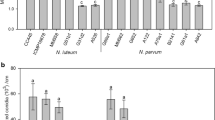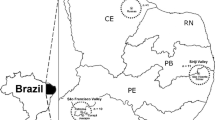Abstract
Several hyphomycetes were recently isolated from asymptomatic or symptomatic vascular tissues of grapevines showing Petri disease symptoms in South Africa. In most cases, their status as pathogens was unknown and pathogenicity studies were, therefore, conducted to determine their potential as decline pathogens. The fungi included Acremonium cf. charticola, Acremonium cf. ochraceum, Cadophora luteo-olivacea, Phialemonium cf. curvatum, Pleurostomophora richardsiae, Phaeoacremonium (Pm.) krajdenii, Pm. parasiticum, Pm. subulatum, Pm. venezuelense and Pm. viticola. Of these, Pm. parasiticum and Pm. viticola have been associated with Petri disease symptoms, although their pathogenicity has not been tested. Phaeomoniella (Pa.) chlamydospora and Pm. aleophilum, known to be involved in Petri disease and esca, were included as positive controls. Pathogenicity studies were conducted in glasshouse experiments where grapevine rootstocks were artificially inoculated, as well as in the field. Data obtained after 3 months from a glasshouse trial were difficult to interpret, due to the small lesions and similarity in disease expression among different species. However, Pa. chlamydospora produced the largest lesions and was by far the most aggressive pathogen. To supplement the glasshouse trial, grapevine trunks and pruning wounds of Vitis vinifera cv. Periquita were artificially inoculated in the field. Field trials, rated after 14 months, confirmed Pa. chlamydospora to be the most aggressive pathogen, since it produced the largest trunk and pruning wound lesions. Furthermore, it was re-isolated more frequently than any of the other fungi, especially from the pruning wounds. All the fungi were able to infect, colonise and produce lesions statistically different to those caused by the water control and the non-pathogen in the field trial.
Similar content being viewed by others
References
Adalat K, Whiting C, Rooney S, Gubler WD (2000) Pathogenicity of three species of Phaeoacremonium spp. on grapevine in California. Phytopathologia Mediterranea 39, 92–99.
Bertelli E, Mugnai L, Surico G (1998) Presence of Phaeoacremonium chlamydosporum in apparently healthy rooted grapevine cuttings. Phytopathologia Mediterranea 37, 79–82.
Bruno G, Sparapano L (2005) Antagonistic behaviour of Phaeomoniella chlamydospora and Phaeoacremonium spp. vs. Fomitiporia mediterranea: isolation, purification, chemical and biological characterisation of active compounds. Phytopathologia Mediterranea 44, 101–102.
Crous PW, Gams W (2000) Phaeomoniella chlamydospora gen. et comb. nov. a causal organism of Petri grapevine decline and esca. Phytopathology Mediterranea 39, 112–118.
Crous PW, Gams W, Wingfield MJ, Van Wyk PS (1996) Phaeoacremonium gen. nov. associated with wilt and decline diseases of woody hosts and human infections. Mycologia 88, 786–796.
De Hoog GS, Guarro J, Gené J, Figueras MJ (Eds) (2000) Hyphomycetes. Genus: Phaeoacremonium. In ‘Atlas of clinical fungi’. 2nd edn. pp. 846–852. (Centraalbureau voor Schimmelcultures: Utrecht, The Netherlands)
Dhanasekaran V, Mostert L, Jeewon R, Gams W, Hyde KD, Crous PW (2004) Pleurostomophora, an anamorph of Pleurostoma (Calosphaeriales), a new anamorph genus morphologically similar to Phialophora. Studies in Mycology 50, 387–395.
Di Marco S, Calzarano F, Osti F, Mazzullo A (2004) Pathogenicity of fungi associated with decay of kiwifruit. Australasian Plant Pathology 33, 337–342. doi: 10.1071/AP04024
Domsch KH, Gams W, Anderson T-H (1980) ‘Compendium of soil fungi. Vol. I.’ (Academic Press: London)
Dupont J, Laloui J, Magnin S, Larignon P, Roquebert M-F (2000) Phaeoacremonium viticola, a new species associated with Esca disease of grapevine in France. Mycologia 92, 499–504.
Dupont J, Magnin S, Césari C, Gatica M (2002) ITS and b-tubulin markers help delineate Phaeoacremonium species, and the occurrence of P. parasiticum in grapevine disease in Argentina. Mycological Research 106, 1143–1150. doi: 10.1017/S0953756202006639
Edwards J, Pascoe IG, Salib S, Laukart N (2003) Phaeomoniella chlamydospora can be spread into canes from the trunks of infected grapevine mother vines. In ‘Proceedings of the 8th international congress of plant pathology, Christchurch, New Zealand, 2–8 February. Vol. 2’. (Eds D Swain, S Zydenbos) Abstract 29.3, p. 363. (International Society for Plant Pathology: Christchurch, New Zealand)
Eskalen A, Gubler WD (2001) Association of spores of Phaeomoniella chlamydospora, Phaeoacremonium inflatipes, and Pm. aleophilum with grapevine cordons in California. Phytopathologia Mediterranea 40, S429-S432.
Ferreira JHS (1998) Phialophora terugsterwing — ‘n algemene probleem by jong wingerde. Wynboer Tegnies 104, 6–8.
Ferreira JHS, Van Wyk PS, Venter E (1994) Slow dieback of grapevine: association of Phialophora parasitica with slow dieback of grapevines. South African Journal of Enology and Viticulture 15, 9–11.
Ferreira JHS, Van Wyk PS, Calitz FJ (1999) Slow dieback of grapevine in South Africa: stress-related predisposition of young vines for infection by Phaeoacremonium chlamydosporum. South African Journal of Enology and Viticulture 20, 43–46.
Fourie PH, Halleen F (2001) Diagnose van swamsiektes en hul betrokkenheid by terugsterwing van jong wingerd. Wynboer 149, 19–23.
Fourie PH, Halleen F (2002) Investigation on the occurrence of Phaeomoniella chlamydospora in canes of rootstock mother vines. Australasian Plant Pathology 31, 425–426. doi: 10.1071/AP02049
Fourie PH, Halleen F (2004) Proactive control of Petri disease of grapevine through treatment of propagation material. Plant Disease 88, 1241–1245.
Fourie PH, Halleen F, Groenewald M, Crous PW (2000a) Black Goo decline of grapevine: current understanding of this mysterious disease. Wynboer 130, 11–14.
Fourie PH, Halleen F, Volkmann AS (2000b) Fungi associated with grape wood, root and trunk diseases: a summary of the 1999–2000 results from the diagnostic service at Nietvoorbij. In ‘Proceedings of the 2nd international viticulture & enology congress, November 8–10, Cape Town, South Africa’. (Ed. P Gousard) p. 12. (South African Society for Enology and Viticulture: Stellenbosch) [Abstract]
Gams W (1971) ‘Cephalosporium-artige Schimmelpilze (Hyphomycetes).’ (Gustav Fischer Verlag: Stuttgart)
Gams W (2000) Phialophora and some similar morphologically little-differentiated anamorphs of divergent ascomycetes. Studies in Mycology 45, 187–199.
Gams W, McGinnis MR (1983) Phialemonium, a new anamorph genus intermediate between Phialophora and Acremonium. Mycologia 75, 977–987.
Gams W, Hoekstra ES, Aptroot A (Eds) (1998) ‘CBS course of mycology.’ 4th edn. (Centraalbureau voor Schimmelcultures: Baarn, The Netherlands)
Gatica M, Césari C, Magnin S, Dupont J (2001) Phaeoacremonium species and Phaeomoniella chlamydospora in vines showing “hoja de malvón” and young vine decline symptoms in Argentina. Phytopathologia Mediterranea 40, S317-S324.
Groenewald M, Kang J, Crous PW, Gams W (2001) ITS and β-tubulin phylogeny of Phaeoacremonium and Phaeomoniella species. Mycological Research 105, 651–657. doi: 10.1017/S0953756201004282
Gubler WD, Eskalen A, Feliciano AJ, Khan A (2001) Susceptibility of grapevine pruning wounds to Phaeomoniella chlamydospora and Phaeoacremonium spp. Phytopathologia Mediterranea 40, S482-S483.
Halleen F, Crous PW, Petrini O (2003) Fungi associated with healthy grapevine cuttings in nurseries, with special reference to pathogens involved in the decline of young vines. Australasian Plant Pathology 32, 47–52. doi: 10.1071/AP02062
Harrington TC, McNew DL (2003) Phylogenetic analysis places the Phialophora-like anamorph genus Cadophora in the Helotiales. Mycotaxon 83, 141–151.
Larignon P, Dubos B (1997) Fungi associated with esca disease in grapevines. European Journal of Plant Pathology 103, 147–157. doi: 10.1023/A:1008638409410
Larignon P, Dubos B (2000) Preliminary studies on the biology of Phaeoacremonium. Phytopathologia Mediterranea 39, 184–189.
Lee SB, Taylor JW (1990) Isolation of DNA from fungal mycelia and single spores. In ‘PCR protocols: a guide to methods and applications’. (Eds MA Innis, DH Gelfand, JJ Sninsky, TJ White) pp. 282–287. (Academic Press: New York)
Mengistu A, Grau CR (1986) Variation in morphological, cultural, and pathological characteristics of Phialophora gregata and Acremonium sp. recovered from soybean in Wisconsin. Plant Disease 70, 1005–1009.
Mostert L, Crous PW, Petrini O (2000) Endophytic fungi associated with shoots and leaves of Vitis vinifera, with specific reference to Phomopsis viticola complex. Sydowia 52, 46–58.
Mostert L, Crous PW, Groenewald JZ, Gams W, Summerbell R (2003) Togninia (Calosphaeriales) is confirmed as teleomorph of Phaeoacremonium by means of morphology, sexual compatibility, and DNA phylogeny. Mycologia 95, 646–659.
Mostert L, Groenewald JZ, Summerbell RC, Robert V, Sutton DA, Padhye AA, Crous PW (2005) Species of Phaeoacremonium associated with human infections and environmental reservoirs in infected woody hosts. Journal of Clinical Microbiology 43, 1752–1767. doi: 10.1128/JCM.43.4.1752-1767.2005
Mostert L, Groenewald JZ, Summerbell RC, Gams W, Crous PW (2006) Taxonomy and pathology of Togninia (Diaporthales) and its Phaeoacremonium anamorphs. Studies in Mycology 54, 1–115.
Mugnai L, Graniti A, Surico G (1999) Esca (black measles) and brown wood streaking, two old and elusive diseases of grapevine. Plant Disease 83, 404–418.
Overton BE, Stewart EL, Wenner NG (2005a) Molecular phylogenetics of grapevine decline fungi from Pennsylvania and New York. Phytopathologia Mediterranea 44, 90–91.
Ovrton BE, Stewart EL, Qu X, Wenner NG, Christ BJ, Gildow FE (2005b) Real-Time PCR-SYBR Green detection of grapevine decline pathogens. Phytopathologia Mediterranea 44, 85.
Pascoe I, Cottral E (2000) Developments in grapevine trunk diseases research in Australia. Phytopathologia Mediterranea 39, 68–75.
Retief E, McLeod A, Fourie PH (2006) Potential inoculum sources of Phaeomoniella chlamydospora in South African grapevine nurseries. European Journal of Plant Pathology 115, 331–339. doi: 10.1007/s10658-006-9025-4
SAS (1999) ‘SAS/STAT User’s Guide. Version 8. Vol. 2.’ 1st edn. (SAS Institute: Cary, NC)
Scheck HJ, Vasquez SJ, Fogle D, Gubler WD (1998) Grape growers report losses to black-foot and grapevine decline. California Agriculture 52, 19–23.
Schol-Schwarz MB (1970) Revision of the genus Phialophora. Persoonia 6, 59–94.
Shapiro SS, Wilk MB (1965) An analysis of variance test for normality (complete samples). Biometrika 52, 591–611.
Sparapano L, Bruno G, Graniti A (2001) Three-year observation of grapevines cross-inoculated with esca-associated fungi. Phytopathologia Mediterrenea 40, S376-S386.
Stamp JA (2001) The contribution of imperfections in nursery stock to the decline of young vines in California. Phytopathologia Mediterranea 40, S369-S375.
White TJ, Bruns T, Lee S, Taylor J (1990) Amplification and direct sequencing of fungal ribosomal RNA genes for phylogenetics. In ‘PCR protocols: a guide to methods and applications’. (Eds MA Innis, DH Gelfand, JJ Sninsky, TJ White) pp. 315–322. (Academic Press: New York)
Whiteman SA, Jaspers MV, Stewart A, Ridgway H (2002) Detection of Phaeomoniella chlamydospora in soil using species-specific PCR. New Zealand Plant Protection 55, 139–145.
Whiteman SA, Jaspers MV, Stewart A, Ridgway HJ (2004) Identification of potential sources of Phaeomoniella chlamydospora in the grapevine propagation process. Phytopathologia Mediterranea 43, 152–153.
Author information
Authors and Affiliations
Corresponding author
Rights and permissions
About this article
Cite this article
Halleen, F., Mostert, L. & Crous, P.W. Pathogenicity testing of lesser-known vascular fungi of grapevines. Australasian Plant Pathology 36, 277–285 (2007). https://doi.org/10.1071/AP07019
Received:
Accepted:
Issue Date:
DOI: https://doi.org/10.1071/AP07019




